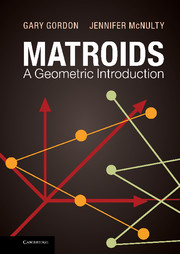3 - New matroids from old
Published online by Cambridge University Press: 05 November 2012
Summary
Given a matroid, how can you use that matroid to create a new matroid? When does a given matroid (or a vector space, or a group, or a ring, …) decompose as a union or a sum of two (or more) smallermatroids? These are important questions, and this chapter attempts to answer them. We beginwith two very important operations on amatroid that aremotivated by graph theory.
Matroid deletion and contraction
This section is devoted to two very important operations we can perform on a matroid: deletion and contraction. Both operations reduce the size of the matroid by removing an element from M; this is frequently useful for proofs involving mathematical induction. Recall that an element e of a matroid is an isthmus if it's in every basis, and e is a loop if it's in no basis. (For a quick review of the different ways to describe an isthmus and a loop, see Exercises 6 and 7 from Chapter 2.)
Definition 3.1. Let M be a matroid on the ground set E with independent sets I.
Deletion
(1) Deletion For e ∈ E (e not an isthmus), the matroid M − e has ground set E − {e} and independent sets that are those members of I that do not contain e:
I is independent in M − e if and only if e ∉ I and I is independent in M.
Information
- Type
- Chapter
- Information
- Matroids: A Geometric Introduction , pp. 100 - 151Publisher: Cambridge University PressPrint publication year: 2012
